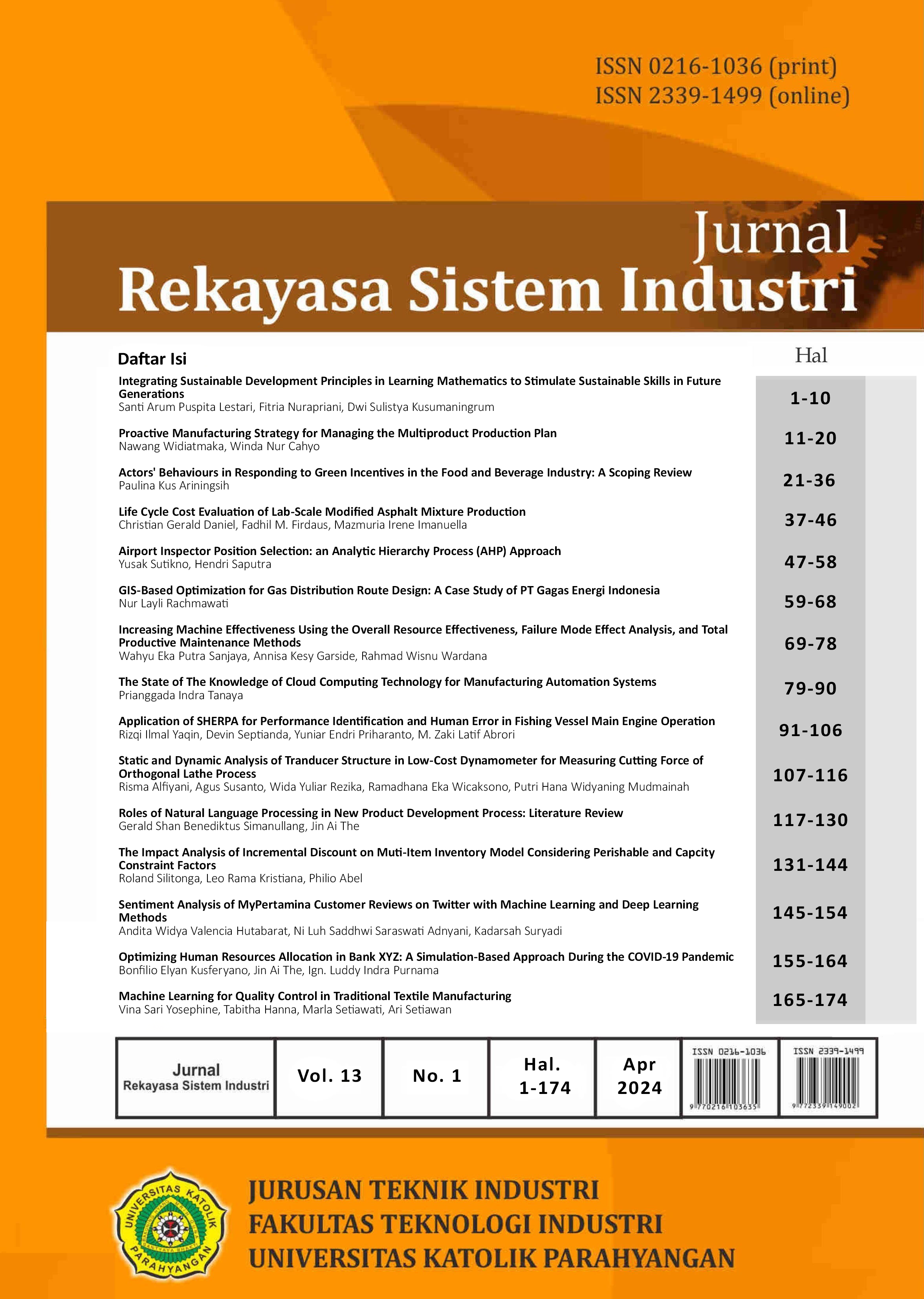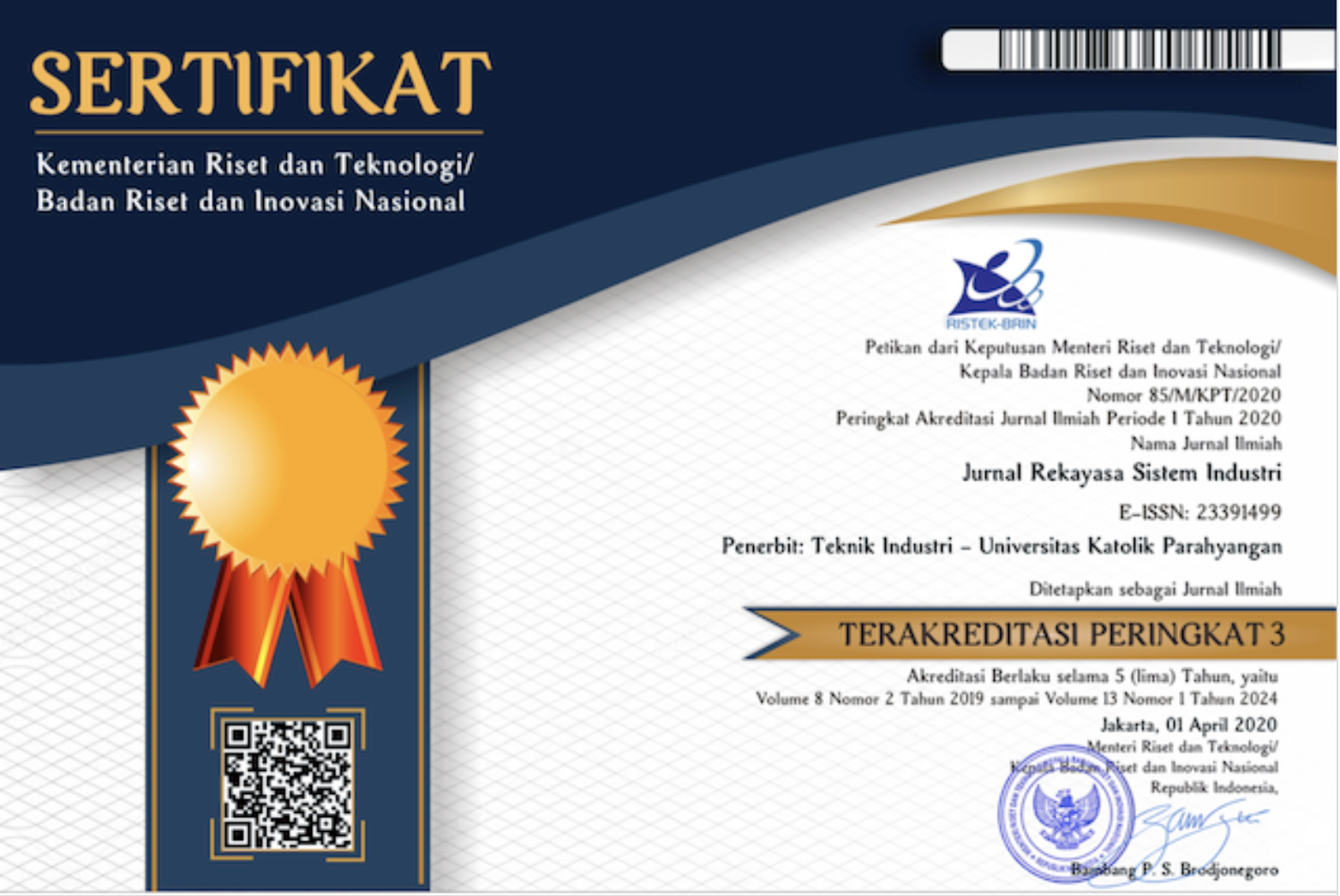Peran Natural Language Processing dalam Proses Pengembangan Produk Baru: Tinjauan Literatur
DOI:
https://doi.org/10.26593/jrsi.v13i1.6790.117-130Kata Kunci:
natural language processing, suara pelanggan, Big Data, pengembangan produk baruAbstrak
Kepuasan pelanggan merupakan faktor kunci kesuksesan sebuah bisnis. Agar dapat menyediakan produk yang memenuhi kepuasan pelanggan, perusahaan harus dapat memahami kebutuhan dan keinginan dari pelanggannya. Perkembangan teknologi pada saat ini telah membantu perusahaan agar dapat memahami keinginan pelanggan dengan lebih mudah sehingga perusahaan dapat menyediakan produk yang memenuhi kepuasan pelanggan. Natural Language Processing (NLP) merupakan teknologi yang memungkinkan komputer mengolah bahasa manusia. NLP telah dimanfaatkan para pelaku bisnis dalam proses New Product Development (NPD). NLP juga sering disebut dengan istilah text-mining. Kami mengumpulkan penelitian-penelitian terkait dengan NLP dan NPD dan melakukan tinjauan literatur untuk memetakan sampai sejauh mana NLP telah dimanfaatkan dalam proses NPD saat ini. Kami menemukan bahwa dalam era Big Data saat ini penelitian-penelitian NLP paling sering memiliki tujuan untuk mengolah data teks dari ulasan online pada e-commerce dan dari media sosial. Dengan menggunakan NLP, data dalam jumlah besar dapat menghasilkan informasi berupa Voice of Customer (VOC) yang berharga untuk pengembangan produk sebuah bisnis. Kami juga menemukan bahwa teknologi NLP juga telah dimanfaatkan dalam proses NPD lain yang tidak melibatkan VOC, seperti tahap desain, pengolahan dokumen hingga ekstraksi kebutuhan-kebutuhan dalam proses NPD.
Referensi
Abad, Z. S. H., Ruhe, G., & Bauer, M. (2017). Understanding Task Interruptions in Service Oriented Software Development Projects: An Exploratory Study. Proceedings - 2017 IEEE/ACM 4th International Workshop on Software Engineering Research and Industrial Practice, SER and IP 2017, 34-40.
Aguwa, C., Olya, M. H., & Monplaisir, L. (2017). Modeling of Fuzzy-based Voice of Customer for Business Decision Analytics. Knowledge-Based Systems, 125, 136-145.
Akella, K., Venkatachalam, N., Gokul, K., Choi, K., & Tyakal, R. (2017). Gain Customer Insights Using NLP Techniques. SAE International Journal of Materials and Manufacturing, 10(3).
Arnarsson, I. Ö., Frost, O., Gustavsson, E., Jirstrand, M., & Malmqvist, J. (2021). Natural Language Processing Methods for Knowledge Management—Applying Document Clustering for Fast Search and Grouping of Engineering Documents. Concurrent Engineering Research and Applications, 29(2), 142-152.
Arnarsson, I. Ö., Frost, O., Gustavsson, E., Stenholm, D., Jirstrand, M., & Malmqvist, J. (2019). Supporting Knowledge Re-use with Effective Searches of Related Engineering Documents - A Comparison of Search Engine and Natural Language Processing-Based Algorithms. Proceedings of the International Conference on Engineering Design, 2019-August, 2597-2606.
Cataltas, M., Dogramaci, S., Yumusak, S., & Oztoprak, K. (2020). Extraction of Product Defects and Opinions from Customer Reviews by Using Text Clustering and Sentiment Analysis. Proceedings - 2020 IEEE International Conference on Big Data, (Big Data 2020), 4529-4534.
Chen, X., Chen, C.-H., Leong, K. F., & Jiang, X. (2013). An Ontology Learning System for Customer Needs Representation in Product Development. International Journal of Advanced Manufacturing Technology, 67(1-4), 441-453.
Choi, J., Yoon, J., Chung, J., Coh, B. Y., & Lee, J. M. (2020). Social Media Analytics and Business Intelligence Research: A Systematic Review. Information Processing and Management, 25, 1-16.
Christophe, F., Mokammel, F., Coatanéa, E., Nguyen, A., Bakhouya, M., & Bernard, A. (2014). A Methodology Supporting Syntactic, Lexical and Semantic Clarification of Requirements in Systems Engineering. International Journal of Product Development, 19(4), 173-190.
Chunawalla, S. A. (2008). Product Management. Global Media.
Dabbish, L., Towne, B., Diesner, J., & Herbsleb, J. (2011). Construction of Association Networks from Communication in Teams Working on Complex Projects. Statistical Analysis and Data Mining, 4(5), 547-563.
Dalpiaz, F., & Parente, M. (2019). RE-SWOT: From User Feedback to Requirements via Competitor Analysis. Lecture Notes in Computer Science (including subseries Lecture Notes in Artificial Intelligence and Lecture Notes in Bioinformatics), 11412 LNCS, 55-70.
Gozuacik, N., Sakar, C. O., & Ozcan, S. (2021). Social Media-based Opinion Retrieval for Product Analysis Using Multi-task Deep Neural Networks. Expert Systems with Applications, 183, 1-13.
Guo, G., Li, H., & Zhou, J. (2013). Customer Unstructured Requirement Analysis Based on Word Semantics and Metaphor Logical Techniques. Zhongguo Jixie Gongcheng/China Mechanical Engineering, 24(8), 995-1000.
Guo, W.-T., & Huynh, V.-N. (2014). A New Version of 2-Tuple Fuzzy Linguistic Screening Evaluation Model in New Product Development. IEEE International Conference on Industrial Engineering and Engineering Management, 164-169.
Gürbüz, E. (2018). Theory of New Product Development and Its Applications. IntechOpen, 7-74.
Han, Y., & Moghaddam, M. (2021). Analysis of Sentiment Expressions for User-centered Design. Expert Systems With Applications, 171, 1-11.
Horber, D., Schleich, B., & Wartzack, S. (2020). Conceptual Model for (Semi-) Automated Derivation of Evaluation Criteria in Requirements Modelling. Proceedings of the Design Society: DESIGN Conference, 1, 937-946.
Hou, T., Yannou, B., Leroy, Y., & Poirson, E. (2019). Mining customer product reviews for product development: A summarization process. Expert Systems with Applications, 132, 141-150.
Ittoo, A., & Bouma, G. (2013). Term Extraction from Sparse, Ungrammatical Domain-Specific Documents. Expert Systems with Applications, 40(7), 2530-2540.
Kim, H., Joung, J., & Kim, K. (2018). Semi-automatic Extraction of Technological Causality from Patents. Computers and Industrial Engineering, 115, 532-542.
Kleiza, K., Klein, P., Franke, M., & Thoben, K.-D. (2016). Integrated Semantic Search in the Product Development Phase. 2010 IEEE International Technology Management Conference, ICE 2010.
Lai, X., Zhang, Q., Chen, Q., Huang, Y., Mao, N., & Liu, J. (2019). The Analytics of Product-Design Requirements Using Dynamic Internet Data: Application to Chinese Smartphone Market. International Journal of Production Research, 57(18), 5660-5684.
Li, G., Law, R., Vu, H. Q., Rong, J., & Zhao, X. (2015). Identifying Emerging Hotel Preferences Using Emerging Pattern Mining Technique. Tourism Management, 46, 311-321.
Lin, K.-Y. (2018). A Text Mining Approach to Capture User Experience for New Product Development. International Journal of Industrial Engineering: Theory Applications and Practice, 25(1), 108-121.
Liu, H., Huang, Y., Wang, Z., Liu, K., Hu, X., & Wang, W. (2019). Personality or value: A Comparative Study of Psychographic Segmentation Based on an Online Review Enhanced Recommender System. Applied Sciences (Switzerland), 9(10), 1992.
Lovaglia, M. J. (1991). Predicting Citations to Journal Articles: The Ideal Number of References. The American Sociologist, 22(1), 49–64.
Lv, W., Lin, F., Wang, W., & Guo, B. (2005). Web-based Knowledge Reuse in Product Design. ISCIT 2005 - International Symposium on Communications and Information Technologies 2005, Proceedings, I, 1056-1059.
Madhusudanan, N., Gurumoorthy, B., & Chakrabarti, A. (2017). Automatic Expert Knowledge Acquisition from Text for Closing the Knowledge Loop in PLM. International Journal of Product Lifecycle Management, 10(4), 301-325.
Mokadam, A., & Suresh, M. A. (2020). DoSSAD - Leveraging Domain Specific Semantics in Aspect Detection for Product Design. IEEE 14th International Conference on Semantic Computing, 249-252.
Nikumanesh, E., & Fathi, M. (2017). An Indicator for Measuring Sentiment and Polarity: Applied Knowledge Discovery Using Online Customer Reviews. IEEE International Conference on Electro Information Technology, 472-475.
Pan, Y., & Stark, R. (2020). An Ensemble Learning based Hierarchical Multi-label Classification Approach to Identify Impacts of Engineering Changes. Proceedings - International Conference on Tools with Artificial Intelligence, ICTAI, 2020-November, 1260-1267.
Prabhu, B. S., Biswas, S., & Pande, S. S. (2001). Intelligent System for Extraction of Product Data from CADD Models. Computers in Industry, 44(1), 79-95.
Qie, Y., Zhu, W., Liu, A., Zhang, Y., Wang, J., Li, T., Li, Y., Ge, Y., & Wang, Y. (2018). A Deep Learning Based Framework for Textual Requirement Analysis and Model Generation. 2018 IEEE CSAA Guidance, Navigation and Control Conference, (CGNCC 2018).
Ramaswamy, S., & DeClerck, N. (2018). Customer Perception Analysis Using Deep Learning and NLP. Procedia Computer Science, 140, 170-178.
Ramdhani, A., Abdullah, M. A., & Amin, S. A. (2014). Writing a Literature Review Research Paper: A step-by-step approach. International Journal of Basic and Applied Science, 3, 47-56.
Rathore, A. K., & Ilavarasan, P. V. (2017). Social Media Analytics for New Product Development: Case of a Pizza. International Conference on Advances in Mechanical, Industrial, Automation and Management Systems, 213-219.
Riesener, M., Dölle, C., Mendl-Heinisch, M., Schuh, G., & Keuper, A. (2020). Derivation of Description Features for Engineering Change Request by Aid of Latent Dirichlet Allocation. Proceedings of the Design Society: DESIGN Conference, 1, 697-706.
Rohman, A. N., Luviana Musyarofah, R., Utami, E. R., & Raharjo, S. (2020). Natural Language Processing on Marketplace Product Review Sentiment Analysis. 2020 2nd International Conference on Cybernetics and Intelligent System (ICORIS 2020).
Schweitzer, G. M., Bitzer, M., & Vielhaber, M. (2021). Artificial Intelligence in Engineering: Evolution of Virtual Product Development in the Context of the Medical Device Industry. Procedia CIRP, 100, 349-354.
Shamim, A., Balakrishnan, V., Tahir, M., & Shiraz, M. (2014). Critical Product Features' Identification Using an Opinion Analyzer. Scientific World Journal, 2014, 340583.
Sun, H., Guo, W., Shao, H., & Rong, B. (2020). Dynamical Mining of Ever-Changing User Requirements: A Product Design and Improvement Perspective. Advanced Engineering Informatics, 46, 101174.
Tezuka, T., & Tanaka, K. (2005). Landmark Extraction: A Web Mining Approach. Springer-Verlag Berlin Heidelberg (pp. 379-396).
Timoshenko, A., & Hauser, J. R. (2019). Identifying Customer Needs from User-generated Content. Marketing Science, 38(1), 1-20.
Trott, P. (2017). Innovation Management and New Product Development (6th ed.). Pearson Education Limited, Edinburgh Gate (pp. 498-499).
Tzokas, N., Hultink, E. J., & Hart, S. (2004). Navigating the New Product Development Process. Industrial Marketing Management, 33(7), 619-626.
Ullah, R., Amblee, N., Kim, W., & Lee, H. (2016). From Valence to Emotions: Exploring the Distribution of Emotions in Online Product Reviews. Decision Support Systems, 81, 41-53.
Wang, K., Tan, R., Peng, Q., Wang, F., Shao, P., & Gao, Z. (2021). A Holistic Method of Complex Product Development Based on a Neural Network-aided Technological Evolution System. Advanced Engineering Informatics, 48, 101294.
Wen, K., Tan, S., Wang, J., Li, R., & Gao, Y. (2013). A Model-Based Transformation Paradigm for Cross-Language Collaborations. Advanced Engineering Informatics, 27(1), 27-37.
Zhou, X., Wang, Z., Li, S., Zhou, G., & Zhang, M. (2020). Emotion Detection with Neural Personal Discrimination. EMNLP-IJCNLP 2019 - 2019 Conference on Empirical Methods in Natural Language Processing and 9th International Joint Conference on Natural Language Processing.
Zichler, K., & Helke, S. (2019). R2BC: Tool-Based Requirements Preparation for Delta Analyses by Conversion into Boilerplates. CEUR Workshop Proceedings.













